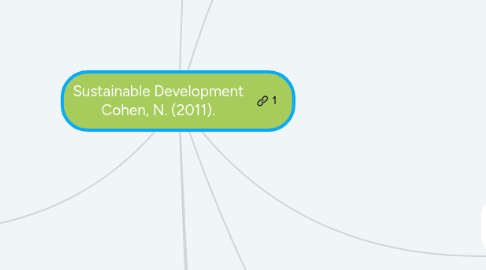
1. -Brundtland Commission in 1987 -United Nations General Assembly (UN) 1983 -The Earth Summit 1992 -United Nations Conference on Human Environment (UNCHE, Stockholm, Sweden, 1972) -World Summit on Sustainable Development (WSSD, Johannesburg, South Africa, 2002)
2. 2.Future Generations and Global Sustainability
2.1. Intergenerational equity
2.1.1. Evaluate current actions with an eye to their consequences far into the future, and ensure that future generations live as well as the current generation.
2.1.1.1. Environmental Protection
2.1.1.1.1. Reduction of some of the environmental impacts of: Industrial productions, such as the steel or automotive industry, which have experienced significant improvements in water use, toxic runoff and soil contamination
2.1.1.1.2. "Millennium Ecosystem Assessment (2005):" The challenge of reversing the degradation of ecosystems and meeting the growing demands for their services can be partially met in some scenarios .... but these imply significant changes in policies, institutions and practices that are not underway "
2.1.1.1.3. Twentieth century
3. 1.The Three Dimensions of Sustainable Development
3.1. Sustainability is based on three essential pillars: 1.Environment 2.Society 3.Economy
3.1.1. The triple bottom line
3.1.2. Triple bottom line
3.1.2.1. It is designing "win-win-win" initiatives that lead to combined benefits for all three pillars.
3.1.3. Limited "win-win" initiatives (two pillars) are encouraged in this perspective
3.1.3.1. Policy also called: "double dividend" European Union and countries of the Organization for Economic Cooperation and Development (OECD)
3.1.3.1.1. Tax shift programs to increase the proportion of environmental taxes, while lowering taxes on labor.
3.2. Analysis: Corporate reports called:-Social Responsibility, Corporate Responsibility or Sustainable Development Reports. Global Reporting Initiative (GRI) Guidelines..
3.2.1. Principles and indicators: Measures and reports on
3.2.1.1. 1.Economic
3.2.1.1.1. -Financial performance -Contributions to sustainability efforts -Infrastructure development -Portfolio development
3.2.1.2. 2.Environmental
3.2.1.2.1. -Development of carbon emissions -Recycling efforts, -Production -Energy consumption -Biodiversity effects -Water use -Emissions -Waste
3.2.1.3. 3.Social performance
3.2.1.3.1. -Amount and type of employment -Turn rate -Collective bargaining rights -Injury rates -Education levels -Health care and corruption
4. Sustainable Design and the Future
4.1. Sustainable Design
4.1.1. Potentially powerful agent of change
4.1.1.1. To carry out he change
4.1.1.1.1. Context
4.1.2. Designers create products that change behavior
4.1.2.1. Design creates the material culture through which a society defines and understands itself.
4.1.2.1.1. A sustainable society requires an increasingly sustainable design
5. Sustainable Development
5.1. Brundtland Sustainable Development Report: Key concepts 1.Needs, particularly essential ones, of the world's poor, to which primary priority must be given. 2. Limitations, and in particular those imposed by the state of technology and the organization on the capacity of the environment to satisfy present and future needs.
5.1.1. Strategy for Sustainable Living 1991. International Union for Conservation of Nature (IUCN), United Nations Environment Program (UNEP) and World Wide Fund for Nature (WWF): Sustainable development is "improving the quality of human life while living within carrying capacity to support ecosystems ".
5.1.2. PNUMA:"The production and use of goods and services that respond to basic needs and provide a better quality of life, while minimizing the use of natural resources, toxic materials and emissions of waste and pollutants during the cycle of life, so as not to endanger the needs of future generations. "
6. SyStems Thinking
6.1. Essence of thought
6.1.1. See a problem as a whole, made up of parts that interact with each other and affect each other.
6.1.1.1. A change in one component of the system has a general impact, affecting all other parts.
6.1.1.1.1. Solutions to problems are found considering these impacts
